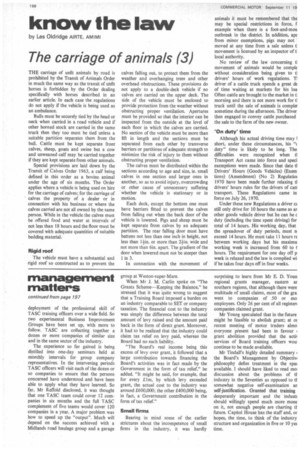know the law
Page 196

If you've noticed an error in this article please click here to report it so we can fix it.
by Les Oldridge AIRTE, AMIMI
The carriage of animals (3)
THE carriage of unfit animals by road is prohibited by the Transit of Animals Order in much the same way as the transit of uhfit horses is forbidden by the Order dealing specifically with horses described in an earlier article. In each case the regulations do not apply if the vehicle is being used as an ambulance.
Bulls must be securely tied by the head or neck when carried in a road vehicle and if other horned stock are carried in the same truck then they too must be tied unless a suitable partition separates them from the bull. Cattle must be kept separate from* calves, sheep, goats and swine but a cow and unweaned calf may be carried together if they are kept separate from other animals.
Special provisions are laid down by the Transit of Calves Order 1963, a calf being defined in this order as a bovine animal under the age of six months. The Order applies where a vehicle is being used on hire for the carriage of calves; for the carriage of calves the property of a dealer or in connection with his business or where the calves carried are not all owned by the same person. While in the vehicle the calves must be offered food and water at intervals of not less than 18 hours and the floor must be covered with adequate quantities of suitable bedding material.
Rigid roof The vehicle must have a substantial and rigid roof so constructed as to prevent the calves falling out, to protect them from the weather and overhanging trees and other overhead obstructions. These provisions do not apply to a double-deck vehicle if no calves are carried on the upper deck. The side of the vehicle must be enclosed to provide protection from the weather without obstructing proper ventilation. Apertures must be provided so that the interior can be inspected from the outside at the level of each floor in which the calves are carried. No section of the vehicle must be more than 8ft in length and the sections must be separated from each other by transverse barriers or partitions of adequate strength to minimize the risk of injury to them without obstructing proper ventilation. • The calves must be distributed within the sections according to age and size, ie. small calves in one section and larger ones in another, so as to avoid injury, overcrowding or other cause of unnecessary suffering whether the vehicle is stationary or in motion.
Each deck, except the bottom one must have barriers fitted to prevent the calves from falling out when the back door of the vehicle is lowered. Pigs and sheep must be kept separate from calves by an adequate partition. The rear falling door must have battens not less than one inch in height, not less than 1-fin. or more than 2+10. wide and not more than 6in. apart. The gradient of the door when lowered must not be steeper than 1 in 3.
In connection with the movement of animals it must be remembered that the may be special restrictions in force, f example when there is a foot-and-mou outbreak in the district. In addition, apt from minor exemptions, pigs may not moved at any time from a sale unless t movement is licensed by an inspector oft: local authority.
No review of the law concerning f movement of animals would be comple without consideration being given to tl drivers' hours of work regulations. T driver of a cattle truck spends a great de of time waiting at markets for his loa Often cattle are brought to the market in t] morning and there is not more work for t truck until the sale of animals is complei sometime during the afternoon. The driver then engaged to convey cattle purchased the sale to the farm of the new owner.
'On duty' time Although his actual driving time may I short, under these circumstances, his "r duty" time is likely to be long. The difficulties were recognized when ti Transport Act came into force and speci exemptions were made. Since that date tl Drivers' Hours (Goods Vehicles) (Exem tions) (Amendment) (No 2) Regulatioi 1970 have been made further relaxing ti drivers' hours rules for the drivers of can transport. These Regulations came in force on July 26, 1970.
Under these new Regulations a driver et still only drive for 10 hours the same as ar other goods vehicle driver but he can be c duty (including the time spent driving) for total of 14 hours. His working day, that the spreadover of duty periods, must n exceed 14 hours. He must take 11 hours re between working days but his maximu working week is increased from 60 to hours. The requirement for one day off p week is relaxed and the law is complied wi if he takes four days off in four weeks.




















































































































































































































































